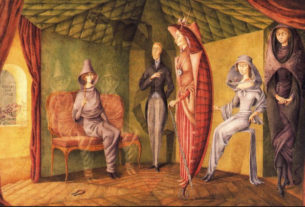The Mexicans can’t dance my legs off, I’ll tell you that — oh, well, in the “barrios” they can, but there the dancing is more like Olympic gymnastics. If you’re just going out in the evening to “dar un chanclazo” (kick the old shoes around) at a neighborhood party or dance hall you can train for it like I do, by climbing eight flights of stairs and walking two hours a day, every day. Live music is inexpensive in Mexico and most of us refuse to dance to tapes.
A friend who used to dance at the Aragon Ballroom in Chicago classifies our dancing here as, “Mexican jumping bean dancing.” “¡Ni maiz, paloma!” (No way, José!) That’s an unfair statement because many of the dance tunes originate in other Latin countries. Placido Domingo dignified this music singing two cumbias in his CD, “De mi alma mexicana” (From My Mexican Soul). He sang “Moliendo Café” and “Caballo Viejo.” The first is translated as “Grinding Coffee” and the second as “Old Horse.” Good, solid song titles. Good, fast music.
My friend is just sour grapes. Dancing in a Mexican ballroom is pure joy. There are hazards, sure, an errant five-inch spike heel on your instep — or, as I admit to, the temporary laming of a fellow dancer with an inadvertent kick to his ankles, but these are just “gajes del oficio” (goes with the territory). Shows our enthusiasm. Thankfully, he didn’t sue.
The band plays its first set pretty slow, songs like, “A Mi Manera,” (“My Way,” made famous by Frankie), a danzón from Cuba (slow, but with a very marked rhythm, I like ‘em), Agustin Lara’s, “Solamente una vez,” (called “You Belong to My Heart” in the U.S.), and maybe some show tunes like “Mackey Navajas” (“Mack the Knife”).
But the band’s second set becomes very Latin and brings on lots of rhythm. A tip of the hat goes to Uncle Sam when they play, “Rock Around the Clock,” but then they’ll go back to a Mexican favorite like, “Camerón Pela’o,” (‘Peeled Shrimp,’ which you’ll instantly agree is another very solid song title). This set of dances may be “puras cumbias” (only cumbias) because they’re the most popular; more people will get up and dance to cumbias than anything else. The “gente grande” (seniors) will get out there on the floor showing the rest of us how to do it, and we’ll see our friend, “el gordito” (fatty), who’s got more rhythm than anybody else on the floor and who is shaking his “panza” (belly) like a bowlful of jelly — and over there is — why, it’s YOU! You’re out there, too, legs churning, arms pumping, being swept away by the powerful rhythms and general delirium of Latin dancing.
Then, just to show they’ve got a mean streak, the band might let down a fast mambo to warn you of what’s coming.
Set Three gets nasty. They play merengues, mambos and quebraditas. Really fast. I always remember the word quebradita because I think it comes from the Spanish verb, “quebrar” (to break) and I think it’s the band’s way of saying, “We’re going to break your back and both legs with this one!” Now is when you have to take tiny little dance steps or you’ll never even approach the tempo.
In Mexican dancing you just do what you want. Twenty couples on the floor, twenty styles, twenty different dance steps. Democracy in action. Just do it “como te dé tu regalada gana” (do what you damn well please). None of that “one step forward — close — one to the side, etc.” No time to think of all that stuff in Mexican dancing. You realize quickly that your fellow dancers are in fine physical condition and decide you should exercise more.
But, oh, barrio dancing! There’s where you see the really good dancers, the best since Gene Kelly hung up his dancing garters. When I’m invited to a dance in one of those working class areas I truly repent that in my youth I abused alcohol, cigarettes, and chocolate cake. Particularly chocolate cake. Watching them is like watching Olympic gymnasts performing at 1000 times their actual speed. I have never heard such music, so fast and so loud. How can the “gente grande” (seniors) move so fast? But they’re out there!
I would gratefully join them but constant chocolate cake abuse makes it impossible.



